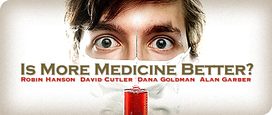My head is dizzy from all the metaphors! What was the monkey doing working in a software company anyway?
There is a very simple identification problem. We know that on average our medical care is worth it — as David Cutler and others have shown. If we cut half — without knowing what to cut — we will likely cut half the value. Yes, we will eliminate some waste, but we also will eliminate some valuable care.
Raising prices does not solve the problem. It is true that the lesson of the Health Insurance Experiment was that we could reduce spending about 30% with minimal loss of health for those with generous coverage. But that was only for those with generous insurance, and it only applied to late 1970’s medical care. We know patients will reduce use of very efficacious care when you raise prices—even care that will save the patient money down the road.
So where do I think Robin Hanson goes astray? He asks:
Do you claim the existence of identifiable treatments with positive benefits, which are cut when spending is cut, shows that aggregate spending variations do give substantial aggregate health gains?
My response is yes. The research on the use of ACE inhibitors by diabetics is a good place to start, but there are many more drug therapies that qualify. And the reason the variations literature ignores it is because they look at treatment after a serious event occurred — when many of the dollars are spent. Heart attacks are the canonical example. And price sensitivity is non-existent once you have had a heart attack. Raising patient cost-sharing will not affect whether the doctor does angioplasty or not, because any reasonable effort to apply prices will have a marginal cost of zero once a catastrophic cap is met.
The irony, though, is that some of these heart attacks could have been prevented if patients took their prescriptions, and here is where aggregate spending variation gives substantial gains. We know patients under-use many medications for primary and secondary prevention.
So I really question whether higher prices will trim the right kind of care. Furthermore, doctors do not behave in a vacuum. We know from studies of C-sections, for example, that when doctors are faced with a loss of income — perhaps due to a decline in fertility rates — they respond by doing more of these expensive procedures. So there is a supply response that we need to consider as well.
Robin Hanson also asks:
Do you argue that savings from medicine cuts would in fact be spent on general utility gains, instead of health gains, which matter little relative to health gains?
If medicine — and insurance against its costs — have no value, why does everyone purchase so much? In our voluntary system, people have the option of avoiding health care except in extreme emergency situations. They can work for an employer who doesn’t provide insurance, and they can choose as much or as little care as they like. Why is this rare? It is precisely because medicine — and insurance against its financial risk — is so valuable. There is no grand conspiracy that has deluded 250 million people into thinking that health care has value, when in fact it does nothing. Clearly there is a lot of value overall; the issue is how we trim the fat, as David Cutler and Alan Garber point out.

